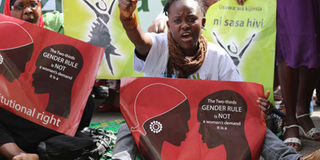Study reveals pay disparities between men and women

Activists in Mathare, Nairobi call for Parliament to implement the gender rule. Study reveals pay disparities between men and women. PHOTO | NATION MEDIA GROUP
What you need to know:
- Norway, Australia, Switzerland, Germany and Denmark occupy the top five positions among the Very High Human Development category.
- Top-ranked African countries are Seychelles, Mauritius, Algeria, Tunisia and Libya, all featuring among countries with High Human Development.
- Males also do better in terms of expected years of schooling at 11.4 compared to 10.8 for females.
Income and education disparities between men and women are still conspicuous in Kenya even as the country makes gains in human development.
The UNDP 2016 report Human Development for Everyone shows that the country has registered an annual average human development index growth of 0.64 per cent from 1990 to 2015.
The progressive gain has seen Kenya climb from position 147 in 2014 to 146 in 2015, though the country remains at near bottom, only above Pakistan in the Medium Human Development group.
Norway, Australia, Switzerland, Germany and Denmark occupy the top five positions among the Very High Human Development category.
Belarus, Oman, Barbados, Uruguay and Bulgaria, which are ranked 52 to 56 occupy the top five positions among the countries with High Human Development.
AVERAGE ACHIEVEMENTS
The Medium Human Development group is topped by Moldova, Botswana, Gabon, Paraguay and Egypt.
Top-ranked African countries are Seychelles, Mauritius, Algeria, Tunisia and Libya, all featuring among countries with High Human Development.
UNDP defines Human Development Index as a summary measure of average achievements in key dimensions: a long and healthy life, being knowledgeable and having a decent standard of living.
With regard to income, the estimated gross national income per capita for males in Kenya was $3,405 (Sh350,715) in 2015 compared to $2,357 (Sh242,771) for females.
GNI per capita reflects the average income of a country’s citizens in dollar terms.
Males also do better in terms of expected years of schooling at 11.4 compared to 10.8 for females.
SOCIAL NORMS
“Women and girls are not able to lead their lives to their full potential in many countries. Gender disparities — while narrowing — are embedded in social norms and patterns of exclusion from household and community decision-making that limit women’s opportunities,” says the report.
According to the study, gender-based discrimination starts before school, “even before birth”.
“The preference for a son can lead to sex-selective abortions particularly, in some South Asian countries. Discrimination continues in families through intra-household resource allocation … Early marriage among girls limits their long-term capabilities and potential,” the report adds.
GENDER RULE
The study comes on the backdrop of a court ruling that requires Parliament to enact a law that would implement the constitutional gender rule.
The proposed law provides that neither gender should be more than two-thirds in Parliament and county assemblies.
In terms of labour force participation, Kenyan males again do better. The labour participation rate for men in 2015 was 72.1 per cent compared to 62.1 per cent for women during the same period.
Life expectancy, meanwhile, for females in the country is estimated at 64.1 years, which is nearly four years more than for males.
The poverty line between 2005-2014 was 45.9 per cent.




